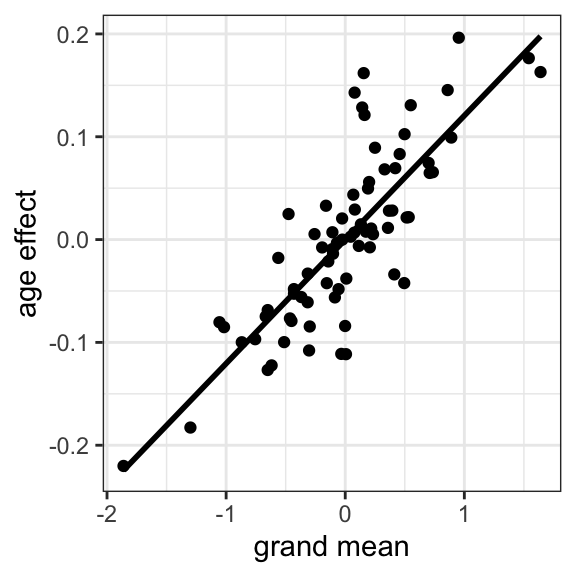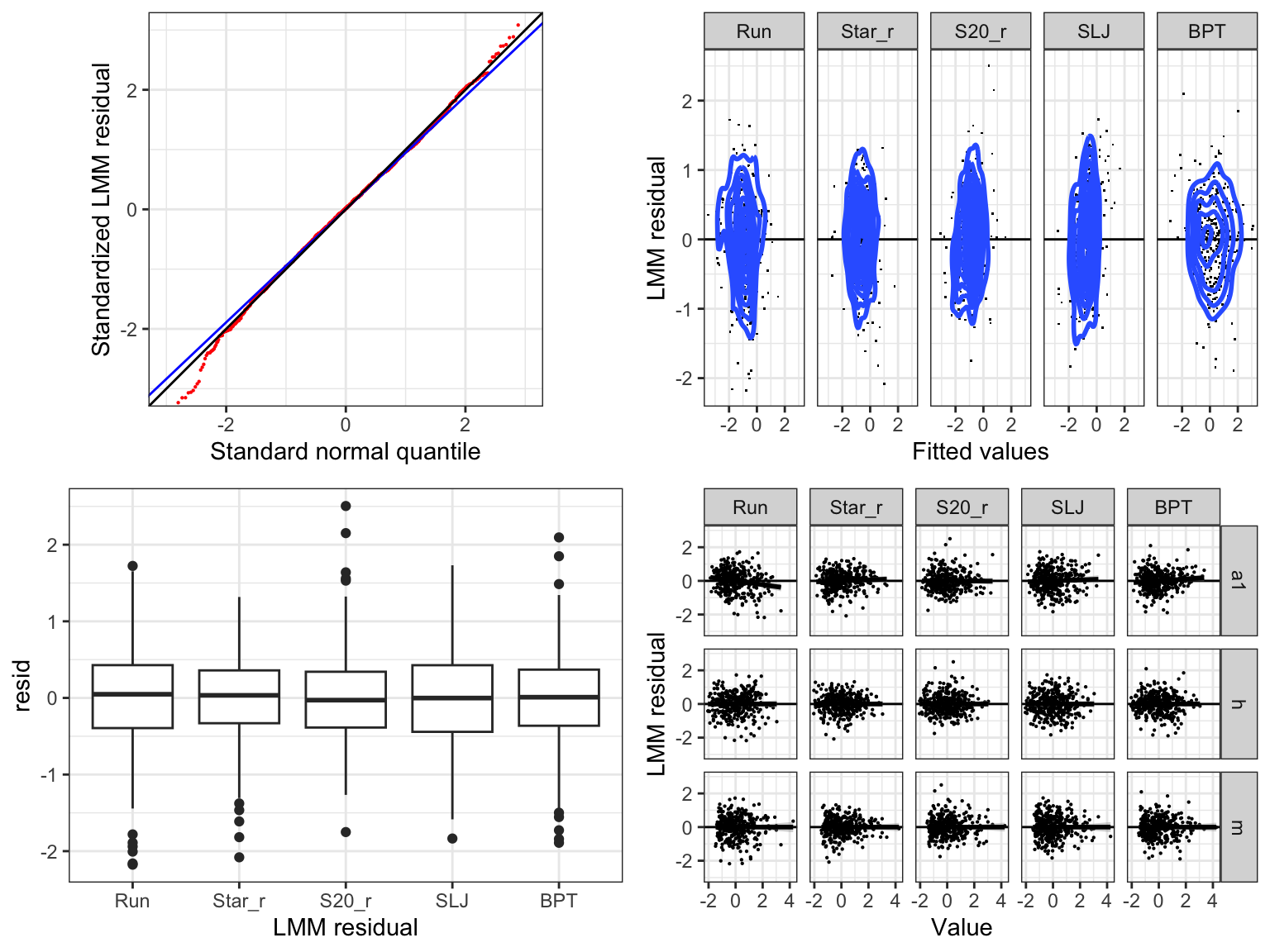Considering the overall positive effects of body height as well as age on physical fitness performances, the question remains whether these effects are associated with growth and maturation of the included children. Further, regarding the positive correlation between the overall level of physical fitness and the magnitude of age effects on an individual level, it remains unclear how these effects are moderated. Accordingly, the following Chapter 5 will assess the effects of age and the maturity offset estimated using two different formulas (Mirwald et al., 2002; Moore et al., 2015) on physical fitness. Of note, as the ball push test might be differently associated with changes in physical fitness associated with growth and age, it was not included in the following analysis to allow a more precise modeling of the effects of age and maturity offset and a latent construct of physical fitness (Fühner et al., 2021). Additionally, age and maturity offset will also be considered on an individual level to analyse whether the positive correlation between age-related effects and overall physical fitness is caused/moderated by more mature children.
Albrecht, C. A. (2015). Entwicklung und einflussfaktoren der entwicklung der motorischen leistungsfähigkeit im kindes- und jugendalter - befunde der MoMo-längsschnittstudie. Pädagogischen Hochschule Karlsruhe.
Asmussen, E., & Heebøll-Nielsen, K. (1955). A dimensional analysis of physical performance and growth in boys.
Journal of Applied Physiology,
7.
https://doi.org/10.1152/jappl.1955.7.6.593
Bates, D. M., Kliegl, R., Vasishth, S., & Baayen, H. (2018). Parsimonious mixed models douglas bates. ArXiv e-Print, Under Revision.
Chung, S. (2015). Body mass index and body composition scaling to height in children and adolescent.
Annals of Pediatric Endocrinology & Metabolism,
20.
https://doi.org/10.6065/apem.2015.20.3.125
Deforche, B., Lefevre, J., Bourdeaudhuij, I. D., Hills, A. P., Duquet, W., & Bouckaert, J. (2003). Physical fitness and physical activity in obese and nonobese flemish youth.
Obesity Research,
11.
https://doi.org/10.1038/oby.2003.59
Ervin, R. B., Fryar, C. D., Wang, C. Y., Miller, I. M., & Ogden, C. L. (2014). Strength and body weight in US children and adolescents.
Pediatrics,
134.
https://doi.org/10.1542/peds.2014-0794
Fühner, T., Granacher, U., Golle, K., & Kliegl, R. (2021). Age and sex effects in physical fitness components of 108,295 third graders including 515 primary schools and 9 cohorts.
Scientific Reports,
11.
https://doi.org/10.1038/s41598-021-97000-4
Giuriato, M., Nevill, A., Kawczynski, A., & Lovecchio, N. (2020). A cross-sectional study of cooper test in children according to allometric scaling.
Journal of Sports Medicine and Physical Fitness,
60.
https://doi.org/10.23736/S0022-4707.19.10282-4
Joensuu, L., Syväoja, H., Kallio, J., Kulmala, J., Kujala, U. M., & Tammelin, T. H. (2018). Objectively measured physical activity, body composition and physical fitness: Cross-sectional associations in 9- to 15-year-old children.
European Journal of Sport Science,
18.
https://doi.org/10.1080/17461391.2018.1457081
Lovecchio, N., Giuriato, M., Zago, M., & Nevill, A. (2019). Identifying the optimal body shape and composition associated with strength outcomes in children and adolescent according to place of residence: An allometric approach.
Journal of Sports Sciences,
37.
https://doi.org/10.1080/02640414.2018.1562615
Ma, X. (2000). Socioeconomic gaps in academic achievement within schools: Are they consistent across subject areas?
International Journal of Phytoremediation,
21.
https://doi.org/10.1076/edre.6.4.337.6935
Mirwald, R. L., Baxter-Jones, A. D. G., Bailey, D. A., & Beunen, G. P. (2002). An assessment of maturity from anthropometric measurements.
Medicine and Science in Sports and Exercise,
34, 689–694.
https://doi.org/10.1249/00005768-200204000-00020
Moore, S. A., McKay, H. A., Macdonald, H., Nettlefold, L., Baxter-Jones, A. D. G., Cameron, N., & Brasher, P. M. A. (2015). Enhancing a somatic maturity prediction model.
Medicine and Science in Sports and Exercise,
47.
https://doi.org/10.1249/MSS.0000000000000588
Nevill, A., Tsiotra, G., Tsimeas, P., & Koutedakis, Y. (2009). Allometric associations between body size, shape, and physical performance of greek children.
Pediatric Exercise Science,
21.
https://doi.org/10.1123/pes.21.2.220
Niessner, C., Granacher, U., & Woll, A. (2021). Entwicklung von kraft, ausdauer, schnelligkeit, beweglichkeit und koordination. In
Pädiatrische Sportmedizin.
https://doi.org/10.1007/978-3-662-61588-1_2
Nieuwenhuis, J., & Xu, J. (2021). Residential segregation and unequal access to schools.
Social Inclusion,
9.
https://doi.org/10.17645/si.v9i2.3606
Norman, A. C., Drinkard, B., McDuffie, J. R., Ghorbani, S., Yanoff, L. B., & Yanovski, J. A. (2005). Influence of excess adiposity on exercise fitness and performance in overweight children and adolescents.
Pediatrics,
115.
https://doi.org/10.1542/peds.2004-1543
Ortega, F. B., Leskošek, B., Blagus, R., Gil-Cosano, J. J., Mäestu, J., Tomkinson, G. R., Ruiz, J. R., Mäestu, E., Starc, G., Milanovic, I., Tammelin, T. H., Sorić, M., Scheuer, C., Carraro, A., Kaj, M., Csányi, T., Sardinha, L. B., Lenoir, M., Emeljanovas, A., … Jurak, G. (2023). European fitness landscape for children and adolescents: Updated reference values, fitness maps and country rankings based on nearly 8 million test results from 34 countries gathered by the FitBack network.
British Journal of Sports Medicine,
57, 299–310.
https://doi.org/10.1136/bjsports-2022-106176
Rittsteiger, L., Hinz, T., Oriwol, D., Wäsche, H., Santos-Hövener, C., & Woll, A. (2021). Sports participation of children and adolescents in germany: Disentangling the influence of parental socioeconomic status.
BMC Public Health,
21.
https://doi.org/10.1186/s12889-021-11284-9
Santos, M. A. M. dos, Nevill, A. M., Buranarugsa, R., Pereira, S., Gomes, T. N. Q. F., Reyes, A., Barnett, L. M., & Maia, J. A. R. (2018). Modeling children’s development in gross motor coordination reveals key modifiable determinants. An allometric approach.
Scandinavian Journal of Medicine and Science in Sports,
28.
https://doi.org/10.1111/sms.13061
Schilling, F., & Kiphard, E. J. (1974). Körperkoordinationstest für kinder. KTK. Beltz; 1974. KTK.
Silva, S., Bustamante, A., Nevill, A., Katzmarzyk, P. T., Freitas, D., Prista, A., & Maia, J. (2016). An allometric modelling approach to identify the optimal body shape associated with, and differences between brazilian and peruvian youth motor performance.
PLoS ONE,
11.
https://doi.org/10.1371/journal.pone.0149493
Teich, P., Fühner, T., Bähr, F., Puta, C., Granacher, U., & Kliegl, R. (2023). The covid pandemic affected the physical fitness of primary school children. Sports Medicine - Open, 9.
Valdivia, A. B., Maia, J., & Nevill, A. (2015). Identifying the ideal body size and shape characteristics associated with children’s physical performance tests in peru.
Scandinavian Journal of Medicine and Science in Sports,
25.
https://doi.org/10.1111/sms.12231
Wang, Z., Zhang, J., Ying, Z., & Heymsfield, S. B. (2012). New insights into scaling of fat-free mass to height across children and adults.
American Journal of Human Biology,
24.
https://doi.org/10.1002/ajhb.22286


